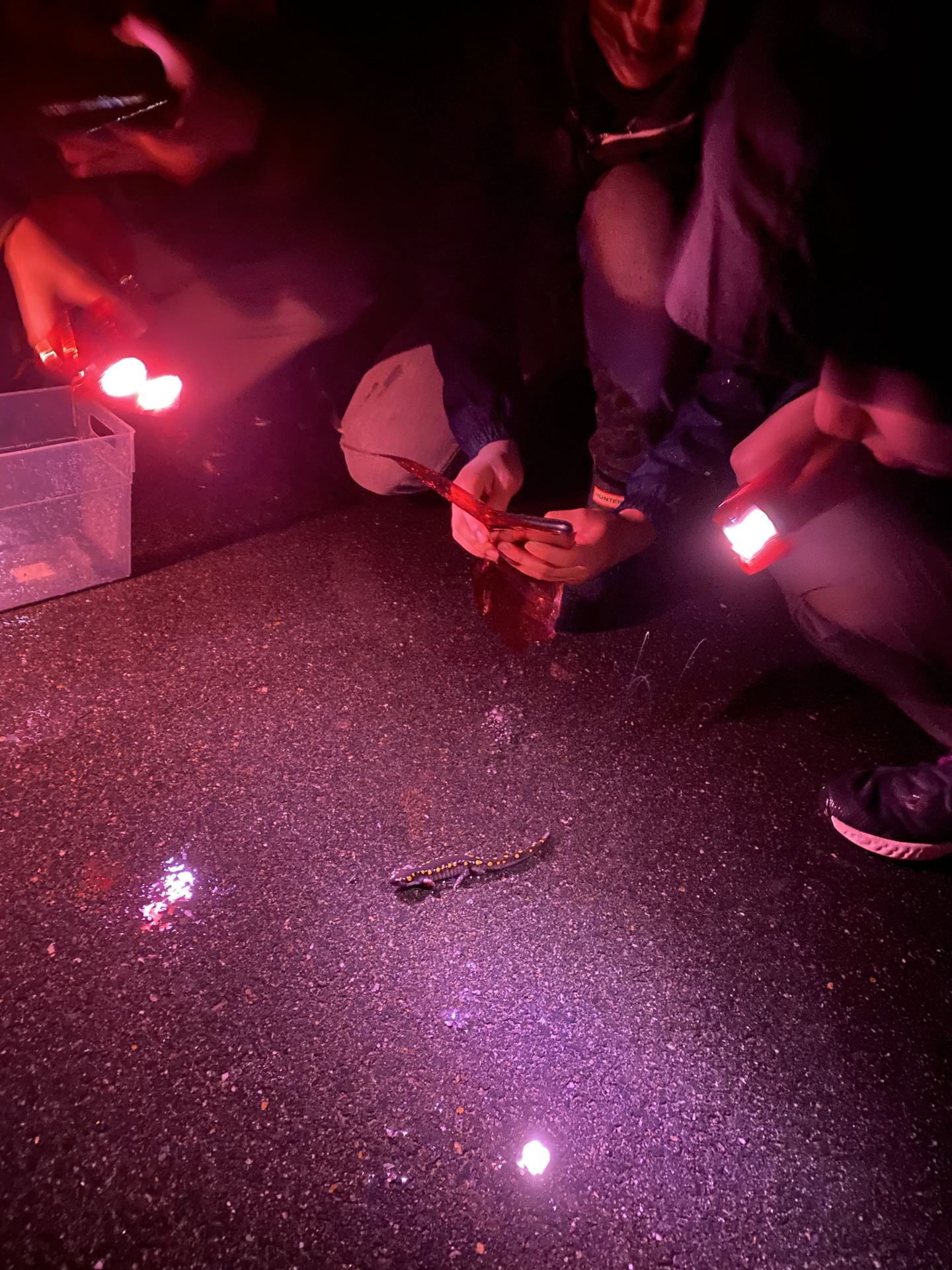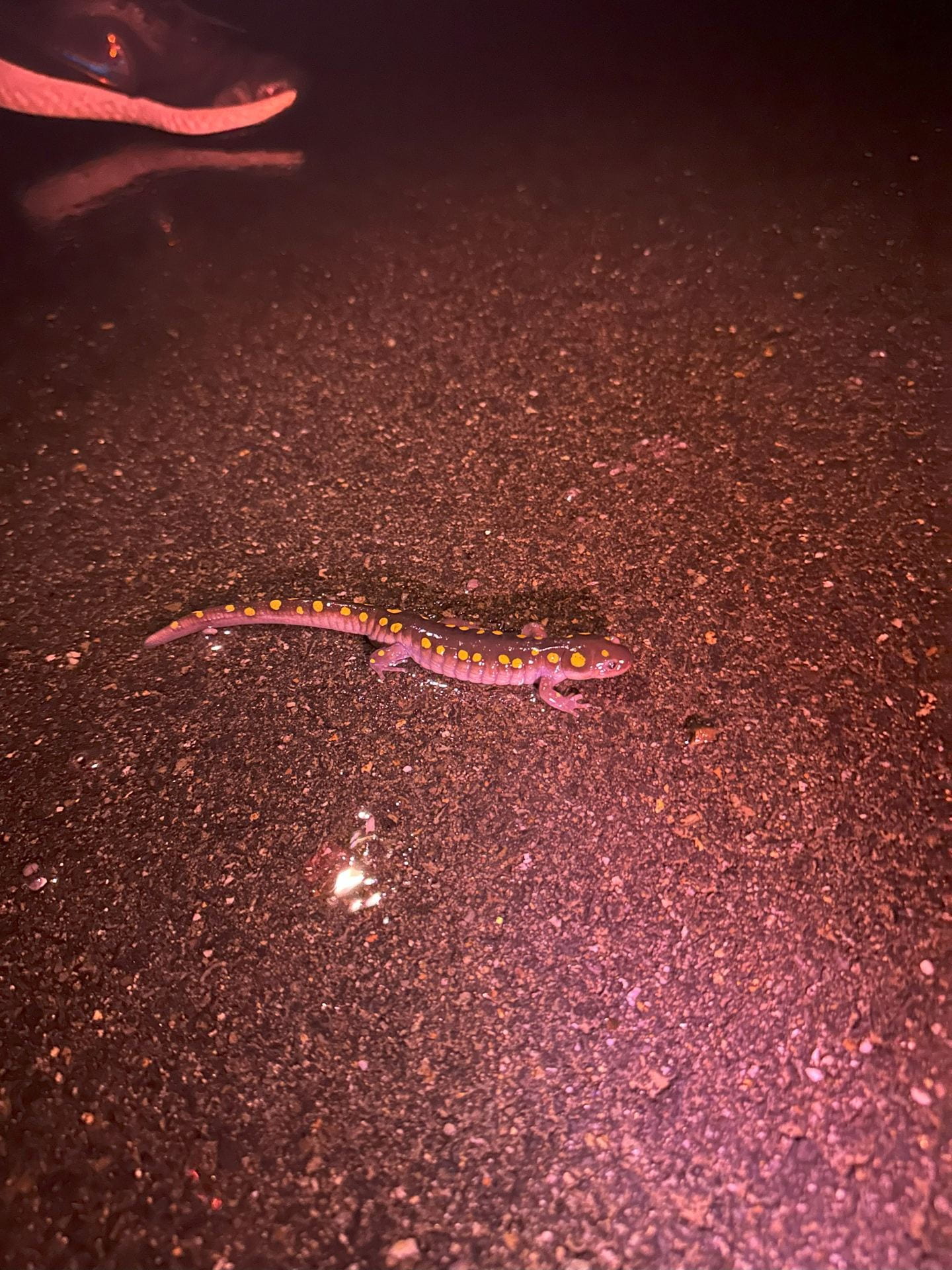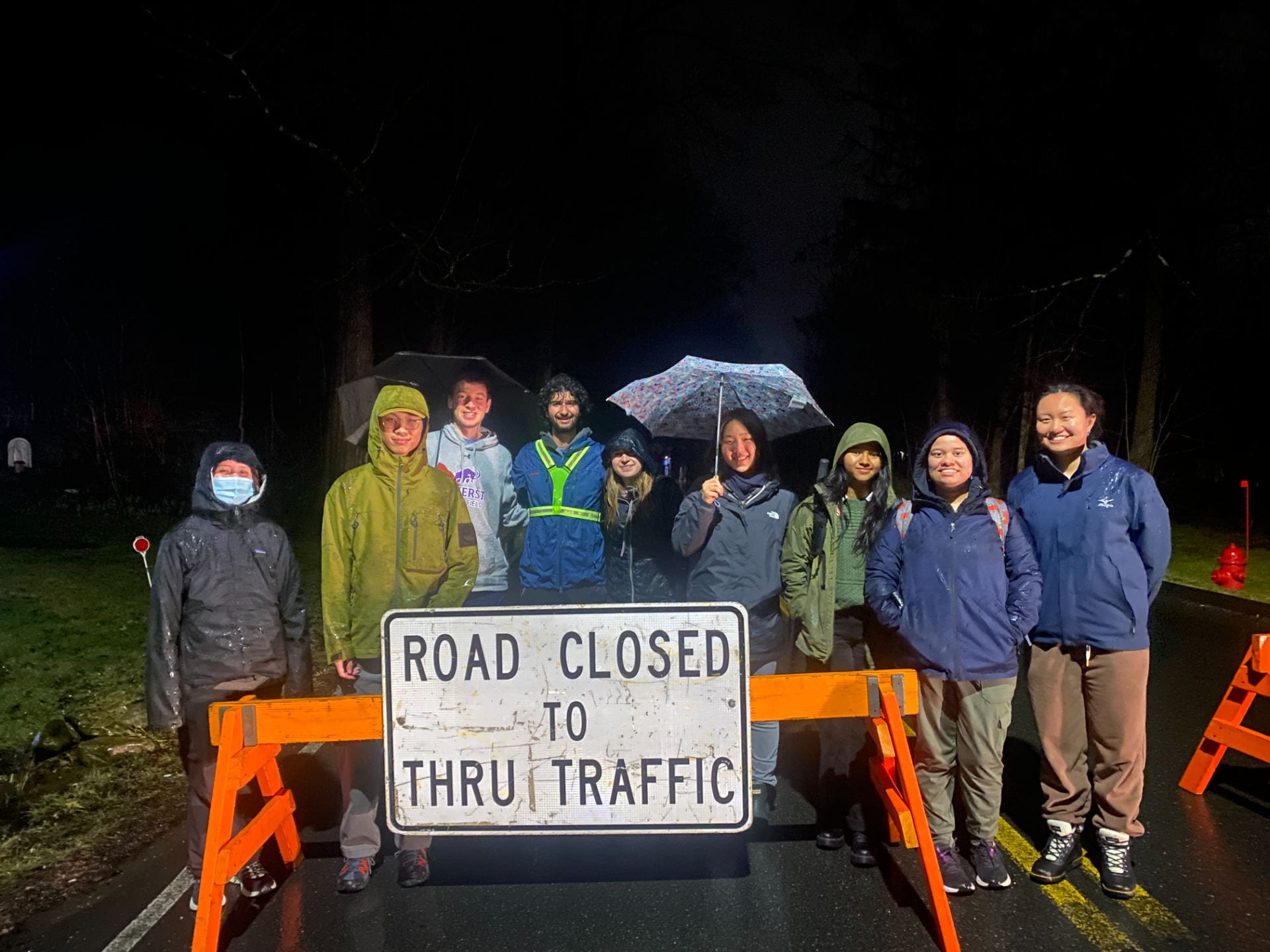By Nora Lowe
You’re wiping rainwater from your brow. The damp darkness is only interrupted by the occasional dull, red light, moving to and fro. No, this spooky scene isn’t an alien abduction, but it is still a big night. In fact, it is the Big Night, when spotted salamanders migrate to reproduce, and Amherst community members gather to witness (and occasionally help out). These amphibians lay their eggs in fish-free freshwater ponds. Such pools are transient, forming from springtime snow melt before evaporating in Autumn.
The small, soft beings actually play a critical role in keeping our ecosystem robust and resilient. Salamanders are one of the main predators for leaf litter-shredding invertebrates. By helping keep leaf litter intact, salamanders are an important part of the carbon cycle, ensuring forest soils store carbon effectively. Essentially, the fewer insects there are to release carbon dioxide from the leaves, the less escapes into the atmosphere to contribute to the greenhouse gas effect. Not only are the salamanders important, but they’re also abundant. Some studies suggest their biomass (i.e., the sum of their weights) is about the same as that of small mammals and around two times more than that of birds.
Miraculously, these spotted creatures return to the same pond every single year. This “learned relationship to the environment” is enabled in part by sensing and orienting according to Earth’s magnetic field. Unsurprisingly, urban sprawl and road development mean navigating is only half the battle, though. Many salamanders must cross the road to get to their pool, which is where things can get dicey. As Robin Wall Kimmerer says in their acclaimed book Braiding Sweetgrass, “[t]heir journey takes about two minutes, and in two minutes anything can happen” (p. 350).
Even though the spotted salamander is luckily categorized under a threat level of “least concern,” one study conducted in Massachusetts postulated that road mortality could lead to their extirpation (a.k.a. local extinction) in a mere 25 years. Due to the acute danger posed by roadways, events such as Amherst’s Big Night have proliferated as of late.
This year’s Big Night came much earlier than expected. Emily Kim (‘25), Amherst Big Night organizer and Biology Steering Committee member, proclaimed in her email subject line on March 6, “DUE TO CLIMATE CHANGE, THE SALAMANDER CROSSING HAS ARRIVED MUCH EARLIER THAN EXPECTED!” Last year, it was on April 1. Despite the short-notice, she quickly rallied the troops (a school van of fellow students).
According to Amherst’s Hitchcock Center for the Environment, salamander motion typically begins as soon as full darkness sets in. If there is continued rain and temperatures remain above 40 degrees Fahrenheit, the migration can even last through the night.
Volunteers arrived at Henry Street (one of the Big Night crossing sites) equipped with red-light flashlights. This color wavelength is less distressing to the salamanders than conventional white-light, which can be blinding and disrupt their normal activity.
Kim found the turnout invigorating and remarked, “it reminds you that people care enough about these small critters to walk outside and get soaked on a Wednesday night, and that in itself is powerful.” She recalled, “we helped two…and saved another from an oncoming car…turns out police only close down the road around sunset, when salamander activity starts, but [they] open it back up around 11 PM or midnight. The process, however, doesn’t end on our time.” In other words, just because we are ready to open the roads again does not mean the migration comes to a neat conclusion.
The fulfillment of saving even a few individuals reminds Kim about an essay by Loren Eiseley called “The Star Thrower.” In it, “a little boy, faced with a beach full of stranded starfish, tirelessly throws one after another back into the pounding waves. ‘You can’t save them all, so why bother trying? Why does it matter, anyway?’ he is asked. Another already in hand, he replies: ‘Well, it matters to this one.’”
And it should matter to us, too, considering the job these spotted salamanders play in supporting our environment’s stability.


It is also worrying that Big Night came so early this year. Kim elaborated, “‘Big Night’ used to be exactly that — one big night a year, when most of the population would migrate after the snowmelt and on the first warm rain. With climate change, there’s been less of the former and more of the latter. Now, the migration happens in bursts, where only portions of the population migrate at one time…I’m sure that there will be reproductive repercussions down the line.”
Aidan Cooper (‘26), who attended the crossing in a separate group from Kim, “saw nearly a dozen individual salamanders, about three quarters of which were actually going in the right direction.” Cooper shared Kim’s concern about the stunningly early migration. “It just makes me wonder what kind of world is being made around us, and whether all of us, salamander-y or otherwise, will be able to keep our rhythms about us.” Perhaps these salamanders’ behavioral changes are a harbinger of what’s to come. Indeed, in evolving climatic conditions, it is still unclear how exactly we will need to adjust our own routines and habits.
Professor of Biology and Environmental Studies Ethan Temeles commented about the necessity of recording fluctuations in salamander migration trends. “You need a long-term data set to see any trend towards earlier migration,” he emphasized. One recent study considered roughly 20 years of climate data in relation to salamander migration timing, but no significant pattern emerged. “That doesn’t mean that there won’t be one with another 10 years of data,” Temeles said. “This is why we record such information — so we can tell when something is changing.”
Many thanks to Emily Kim and Professor Ethan Temeles for pointing me toward appropriate literature to cite in this article.
